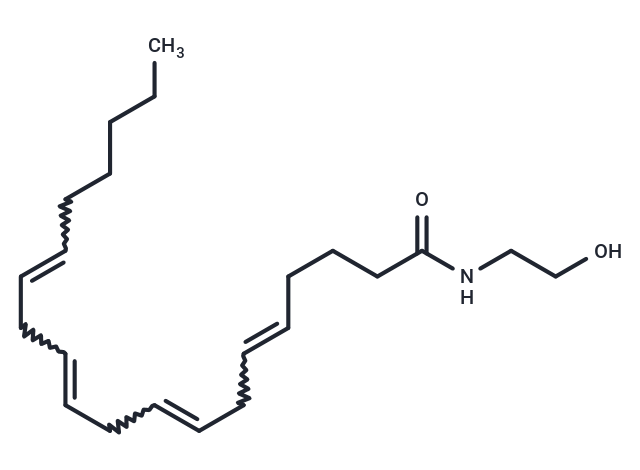Shopping Cart
- Remove All
 Your shopping cart is currently empty
Your shopping cart is currently empty

Anandamide ((5Z,8Z,11Z,14Z)-N-(2-Hydroxyethyl)icosa-5,8,11,14-tetraenamide), an immune modulator, acts via not only cannabinoid receptors (CB1 and CB2) but also other targets (e.g., GPR18/GPR55) in the central nervous system.

| Pack Size | Price | Availability | Quantity |
|---|---|---|---|
| 2 mg | $66 | In Stock | |
| 5 mg | $92 | In Stock | |
| 10 mg | $157 | In Stock | |
| 25 mg | $297 | In Stock | |
| 50 mg | $458 | In Stock | |
| 100 mg | $673 | In Stock | |
| 500 mg | $1,430 | In Stock | |
| 1 mL x 10 mM (in DMSO) | $89 | In Stock |
| Description | Anandamide ((5Z,8Z,11Z,14Z)-N-(2-Hydroxyethyl)icosa-5,8,11,14-tetraenamide), an immune modulator, acts via not only cannabinoid receptors (CB1 and CB2) but also other targets (e.g., GPR18/GPR55) in the central nervous system. |
| In vitro | Anandamide, acting via CB2 receptors, alleviates lipopolysaccharide (LPS)-induced neuroinflammation in rat primary microglial cultures. Endocannabinoids, especially Anandamide (AEA), can activate numerous other receptors like PPARS, TRPV1, and GPR18/GPR55 [1]. |
| In vivo | Anandamide is an endocannabinoid binding both CB1R and CB2R. To evaluate the impact of CBR activation on whole-body glucose homeostasis, glucose tolerance is assessed after a single intraperitoneal Anandamide injection (10 mg/kg). The increase in glycemia in response to glucose ingestion is considerably smaller in mice treated with Anandamide compared with control. It is associated with an improvement of glucose tolerance as illustrated by the AUC0-2h calculations[2]. |
| Alias | (5Z,8Z,11Z,14Z)-N-(2-Hydroxyethyl)icosa-5,8,11,14-tetraenamide |
| Molecular Weight | 347.53 |
| Formula | C22H37NO2 |
| Cas No. | 94421-68-8 |
| Smiles | CCCCCC=CCC=CCC=CCC=CCCCC(=O)NCCO |
| Relative Density. | 0.92 g/cm3 at 25℃ (lit.) |
| Storage | store at low temperature | Powder: -20°C for 3 years | In solvent: -80°C for 1 year | Shipping with blue ice. | ||||||||||||||||||||||||||||||||||||||||
| Solubility Information | Ethanol: 10 mg/mL (28.77 mM), Sonication is recommended. DMSO: 55 mg/mL (158.26 mM), Sonication is recommended. | ||||||||||||||||||||||||||||||||||||||||
Solution Preparation Table | |||||||||||||||||||||||||||||||||||||||||
Ethanol/DMSO
DMSO
| |||||||||||||||||||||||||||||||||||||||||

Copyright © 2015-2025 TargetMol Chemicals Inc. All Rights Reserved.